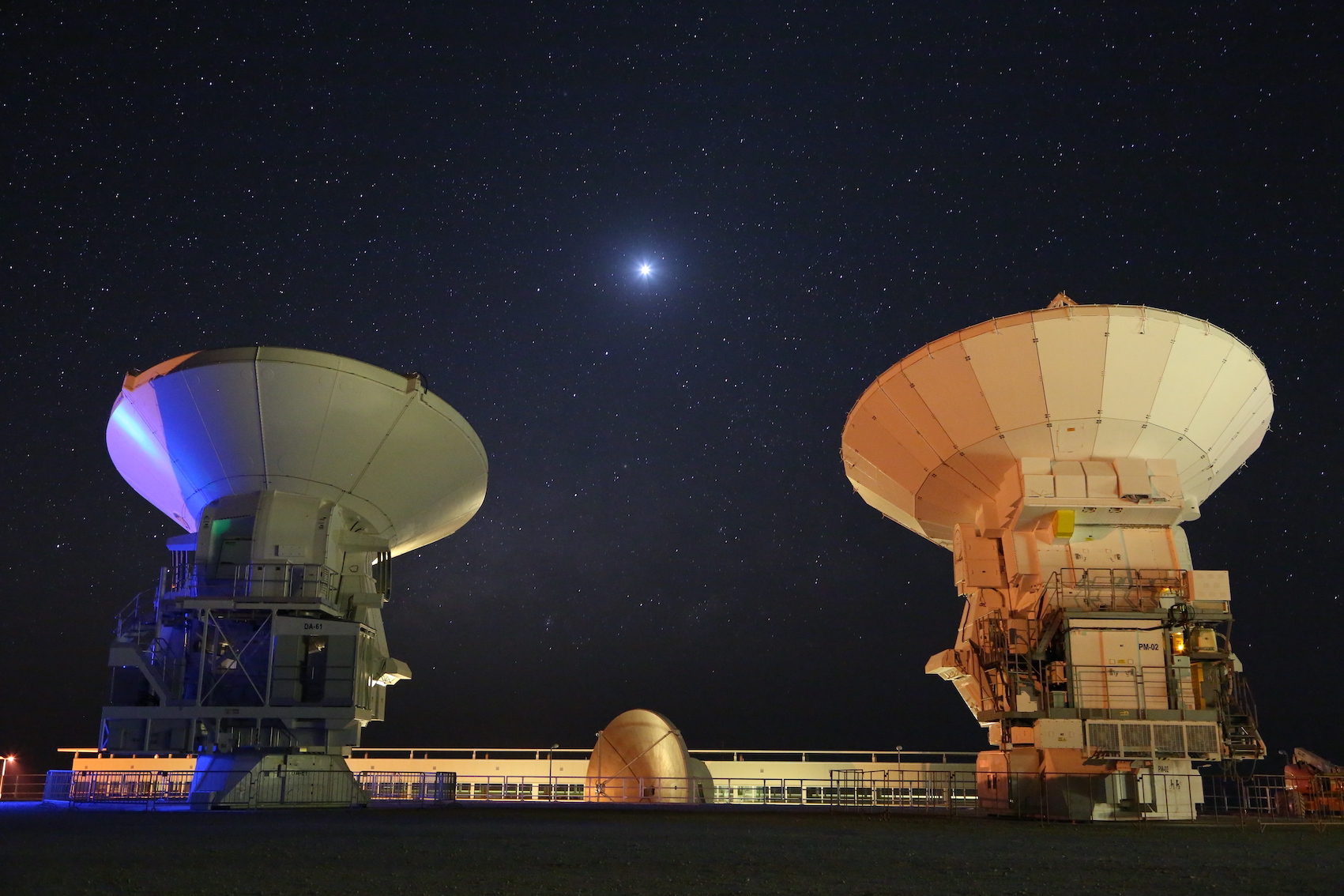Glossary
How the Sky Appears
| Term | Definition |
| Diurnal Motion | As the Earth rotates from west to east each day, the sky (celestial sphere) appears to rotate from east to west about once a day around the rotation axis running through the north and south poles. This apparent motion of the celestial sphere is referred to as diurnal motion. In astronomy observations, we constantly change the pointing of the telescope to track the apparent motion of celestial bodies. See 【Fig.1】 |
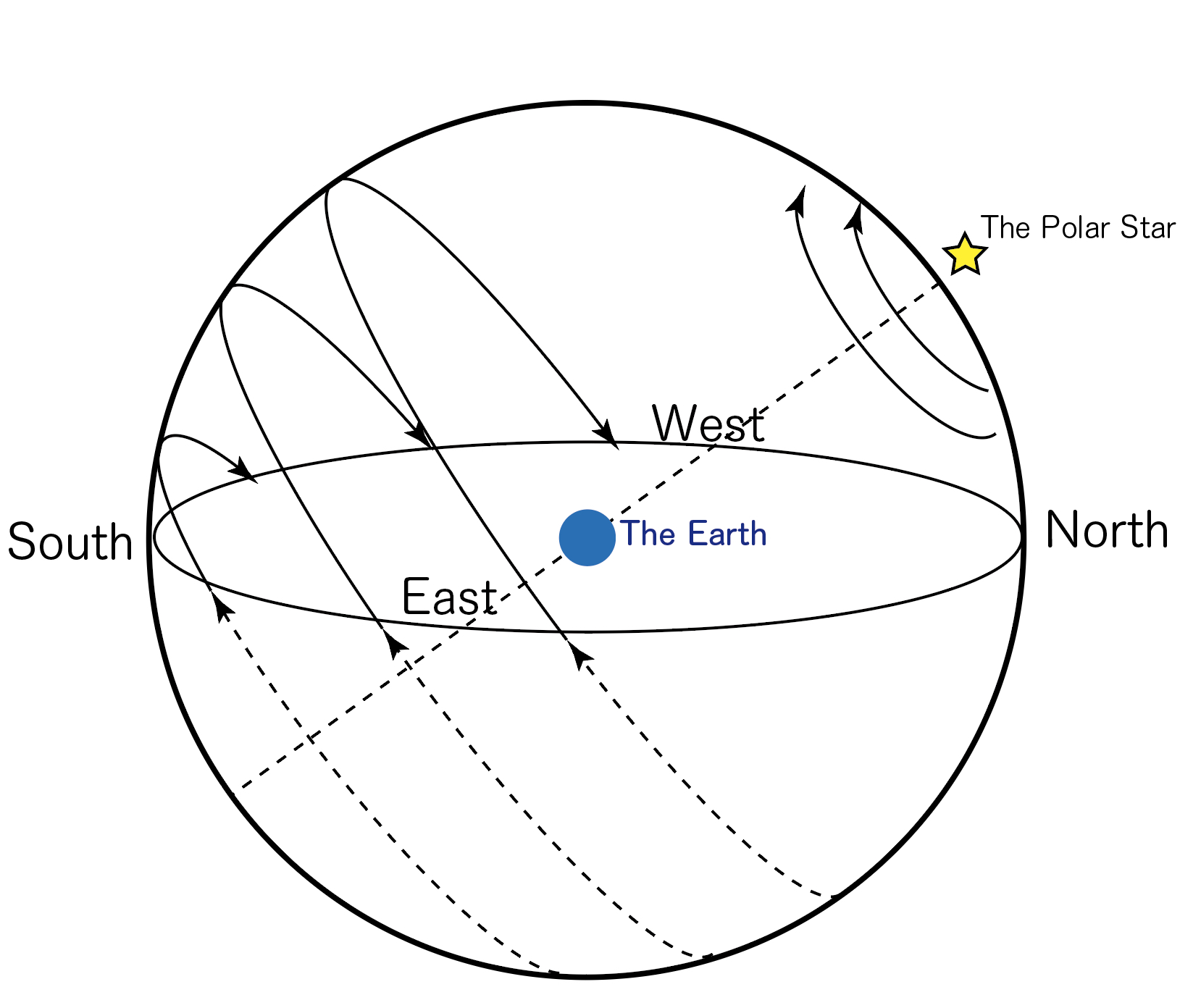
(Image for illustration purposes only.)
Radio Telescope
| Term | Definition |
| Radio Telescope | Radio telescopes are devices that collect and analyze radio waves from celestial bodies. Radio telescopes are completely different from the familiar commercially available telescopes. A radio telescope consists of an antenna, such as a parabolic antenna, that collects invisible radio waves, a receiver that converts radio waves into electrical signals, and a backend, such as a spectrometer, that analyzes the electrical signals. A radio telescope is a precision device that receives weak radio waves from space. The surface of the parabolic antenna must be kept less than 1/20 of a wavelength deviation from an ideal parabola. Deformation caused by gravity, wind, and temperature changes also needs to be minimized. A parabolic antenna is also designed to allow distortion of the antenna to be measured precisely so that fine adjustments can be made. |
| Noise (Electrical Noise) |
Electrical noise can be defined as an unwanted signal which is always present in a communication system.[...].It is usually found that noise is composed of randomly-occurring voltages
which are unrelated in phase or frequency and may sometimes be of a very peaky nature. (F.R. Connor. “Introduction”. Noise, p.1). Noise can reduce the sensitivity of a radio telescope and inhibit signal reception. Noise in a radio telescope can be classified into natural noise, such as lightning and radio waves from celestial bodies other than the target celestial body, and artificial noise generated by electrical equipment and communication equipment. The receivers and other parts of a radio telescopes also generate noise. Therefore, high-sensitivity observations require minimizing the noise from the receiver. Receivers with extremely low noise, thanks to superconducting technology, have been developed and installed in telescopes. |
| Parabolic Antenna | A parabolic antenna is an antenna that transmits or receives radio waves using a surface with the shape of a paraboloid. A parabolic antenna is mainly used when the wavelength of the transmitted or received radio waves is shorter than a centimeter. Parallel wavefronts can be converged to almost a single point by the parabolic reflector, and radio waves radiated from the dish are propagated as plane waves (waves with the same phase). The parabolic antenna has a sharp directivity as shown in 【Fig.2】, and radiates energy in a specific direction more effectively than other antennas. The beam emitted from the antenna has one main lobe and multiple small lobes (side lobes). |
| Main Lobe | The beam facing the front direction is called the main lobe or main beam. |
| Side Lobe | The smaller lobes in the beam pattern other than the main lobe (main beam) are called side lobes. Since the radio waves received by the main and side lobes are indistinguishable, accurate astronomy observation requires low-sensitivity in the side lobes when observing an extended target or a region where celestial bodies are crowded. |
| Back Lobe | A lobe pointing in the opposite direction from the main lobe is called a back lobe. |
| Gain | In general, gain is the amplification in the output of an amplifier as compared to the input signal; it is conventionally expressed in units of decibels (dB). The gain of an antenna is slightly different, it is the ratio of the power output of an antenna pointed in a particular direction as compared to the power output of a standard reference antenna. A radio telescope has a very high gain in the main beam and can receive weak cosmic radio waves in that target direction. |
| Interferometry | Interferometry effectively obtains high resolution by arraying multiple radio telescopes at separate locations and combining the received radio signals to create an interference pattern. Interference signals are obtained by comparing and combining the time differences between the arrival of radio waves from celestial objects to multiple telescopes. By processing (inverse Fourier transformation) a large number of interference signals in a computer, it is possible to reconstruct an image of a target object. |
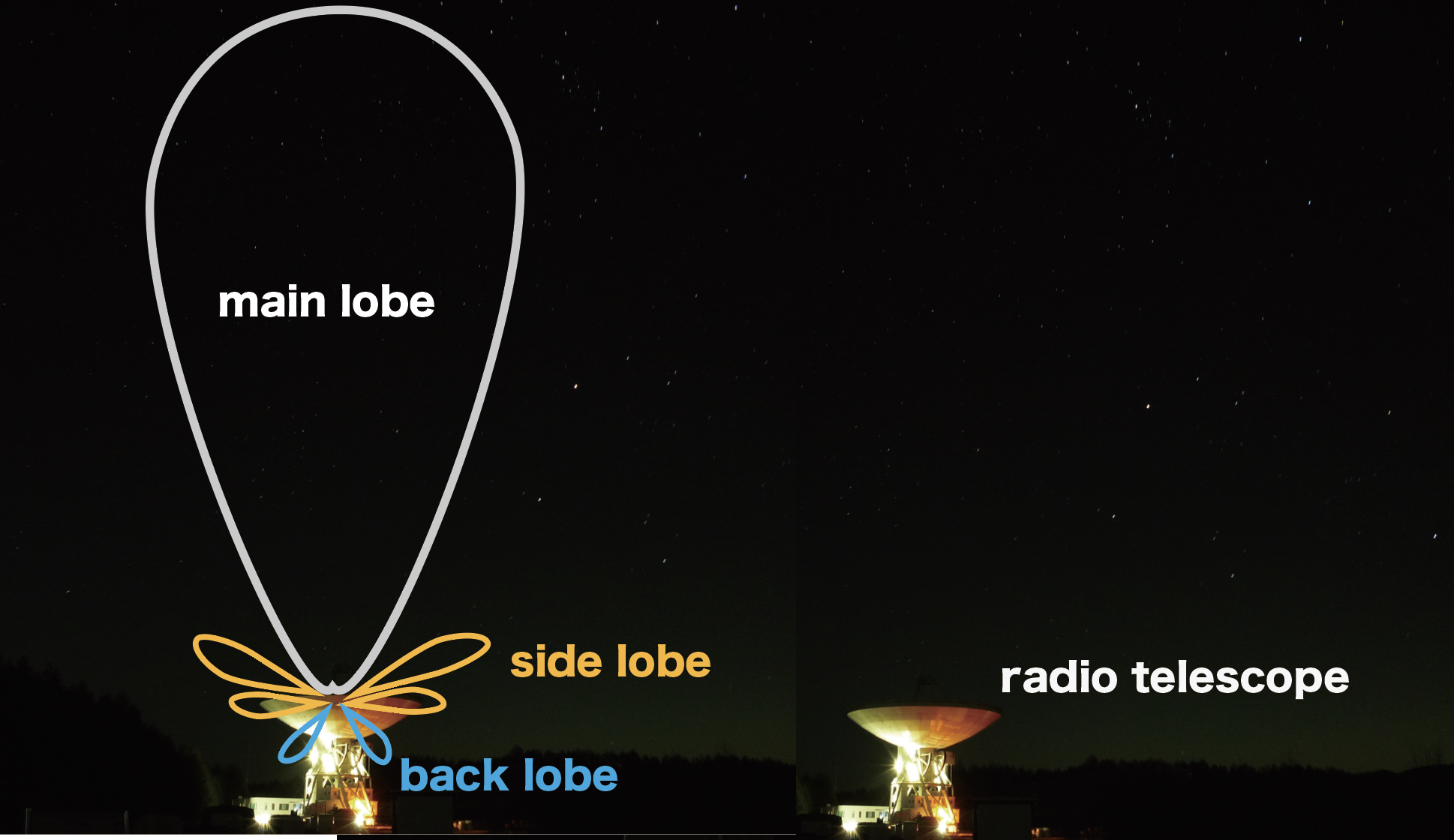
Radio Astronomy, Radio Waves, and Frequencies
| Term | Definition |
| Radio Astronomy | Radio astronomy is a discipline that studies the Universe by observing radio waves from celestial objects including the Sun, planets, interstellar medium, and distant galaxies. Radio flux density is expressed in Jansky (Jy,1 Jy = 10-26 W / m2 / Hz) in radio astronomy. A celestial body with a flux density of 1 Jy is an extremely strong radio source among the objects observed in radio astronomy. Cutting-edge telescopes observe celestial bodies at the µJy (=10-6Jy) level. |
| Electromagnetic Waves | Electromagnetic waves are propagating periodic fluctuations in the electric and magnetic fields that travel through space at the speed of light. They are classified by frequency or wavelength. From longest wavelength (lowest frequency) to shortest wavelength (highest frequency): radio waves, infrared rays, visible light, ultraviolet rays, X-rays, and gamma rays. See 【Fig.3】. |
| Radio Waves | Radio waves are the electromagnetic waves with the longest wavelengths (lowest frequencies); wavelengths of 0.1 mm or more (frequencies of 3000 GHz or less). They are classified by wavelength into metric waves, centimeter waves, millimeter waves, submillimeter waves, and so on. |
| Microwaves | Microwaves are radio waves with a wavelength of 1 meter or less. Microwaves are classified into several bands according to their frequency (wavelength). One example classification scheme is shown in 【Fig.4】. |
| Wavelength | Wavelength is the length of one cycle of a wave.
The relationship between wavelength and frequency is given by the following equation: (Wavelength) x (Frequency) = (Speed of light: Approximately 300,000 kilometers per second in a vacuum) See 【Fig.3】 |
| Hz (Hertz) |
Hertz is a unit of frequency applied to periodic phenomena, and indicates the number of occurrences per second (how many times per second). 1Hz means once per second and is used as a unit of electromagnetic wave frequency. |
| Spectrum (plural: Spectra) |
A spectrum is the intensity distribution by wavelength or frequency of electromagnetic waves, and is obtained by passing electromagnetic waves through a dispersion element such as a prism or diffraction grating. Spectroscopy is a science conducted by means of dividing electromagnetic waves into spectra. Continuum spectra are those in which the intensity of electromagnetic waves changes smoothly with wavelength. Line spectra are those which have sharp features only at specific wavelengths or frequencies. The wavelengths of spectral lines can indicate the existence of atoms and molecules (spectral identification). Spectra are extremely important for determining the physical state and elemental composition of the light emitting source. |

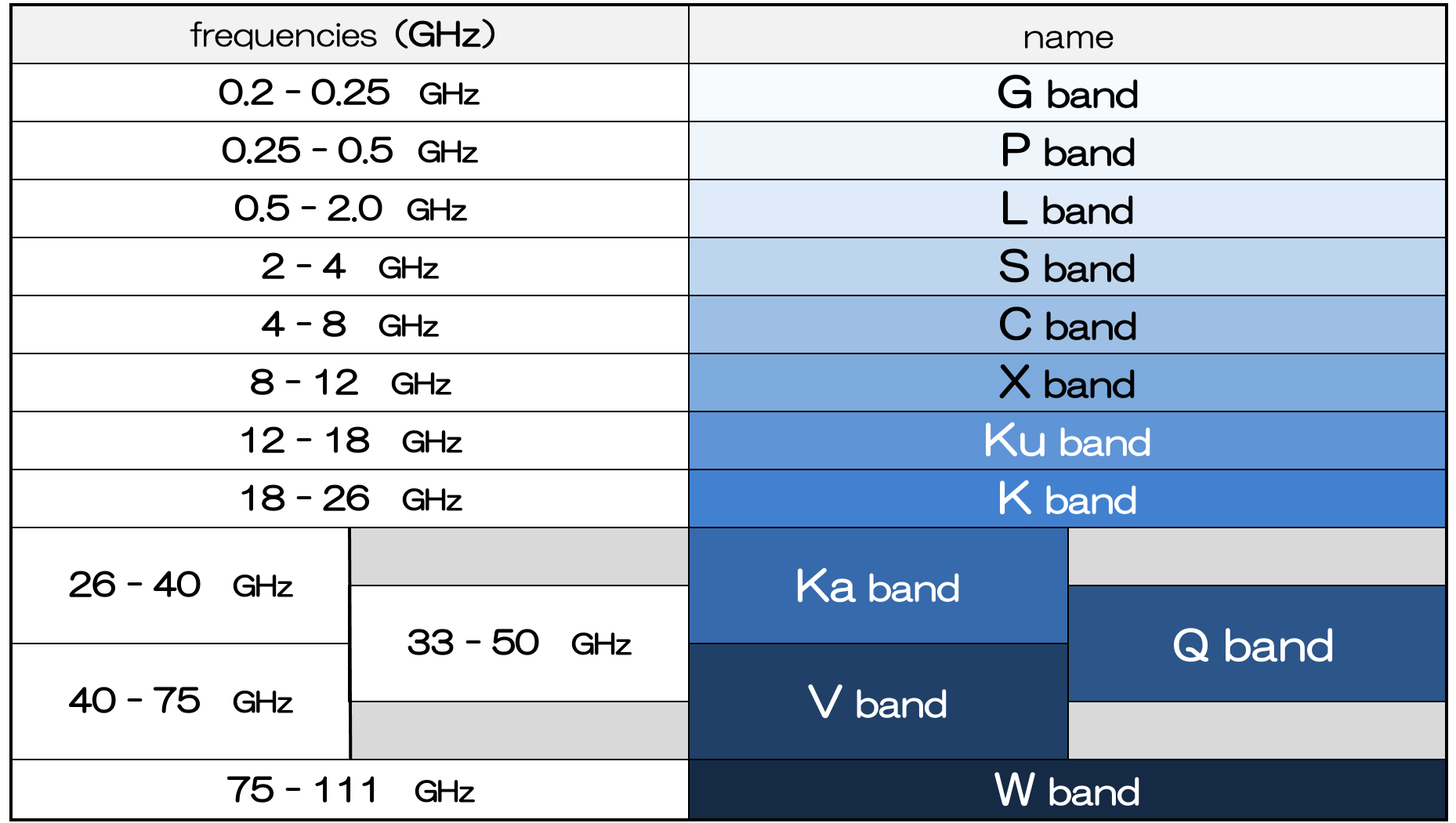
Spectrum Management
| Term | Definition |
| International Telecommunication Union (ITU) |
The International Telecommunication Union (ITU) is the United Nations' specialized agency for information and communication technologies- ICTs. ITU was founded in 1865 to facilitate international connectivity in communications networks. It allocates global radio spectra and satellite orbits, develops the technical standards that ensure networks and technologies seamlessly interconnect, and strives to improve access to ICTs to underserved communities worldwide. One of the specialized sectors in ITU is the Radiocommunication Sector (ITU-R), which is responsible for wireless communications. The standards for frequency allocation are set by the ITU Radio Regulations (RR) revised by the World Radiocommunication Conference (WRC) held by ITU-R. |
| Ministry of Internal Affairs and Communications (MIC) |
The Ministry of Internal Affairs and Communications is the main agency for spectrum use and frequency assignment in Japan. The Global Strategy Bureau, Information and Communications Bureau, and Telecommunications Bureau are responsible for the use of radio waves. They hold working groups to coordinate activities between active and passive services to prevent interference. Their work on the radio wave environment, radio monitoring, and frequency assignment are disclosed to the public on “Radio Use Portal”. |
| Frequency Assignment Plan | “Frequency Assignment Plan" is a table showing assignable frequencies in Japan. The Plan is established and disclosed by the Minister for Internal Affairs and Communications under the provisions of item 1 of Article 26 of the Radio Law. In addition to the table, the Frequency Assignment Plan also includes footnotes for describing additional assignments and regulations. The contents are announced in the official bulletin and posted on the websites of the Communications Bureau, Regional Bureaus of Telecommunications (including the Okinawa Office of Telecommunications), and the Ministry of Internal Affairs and Communications. |
| Primary Service / Secondary Service | A primary service is granted the right to use a frequency or frequencies with priority over secondary services in the Frequency Assignment Plan.
Frequencies are assigned to radio stations of secondary services based on the following conditions: - The use of the frequencies shall not cause harmful interference to stations of primary services to which frequencies are already assigned or to which frequencies may be assigned in the future. - The radio stations cannot claim protection from harmful interference from stations of primary services to which frequencies are already assigned or may be assigned in the future. |
| Passive Service / Active Service | A service emitting and receiving radio waves is called an "active service," and a service which only receives radio waves is called a "passive service." Radio astronomy is a "passive service" because it is reception-only. |
| Radio Astronomy Band | The frequency bands assigned to radio astronomy are called "radio astronomy bands." Radio astronomy observations are conducted not only in radio astronomy bands, but also other bands depending on the research target. |
| Designation as a radio astronomy facility | The Ministry of Internal Affairs and Communications(MIC) designates radio astronomy facilities under Radio Law Article 56-1, which ensures that the operation of recognized radio astronomy facilities will not be obstructed by other services. Those who have a radio astronomy facility can apply to the MIC for its designation, and if accepted, the band designated for protection will be preferentially protected from the radio waves emitted from other services. In addition, the MIC will notify the ITU of a designated radio telescope, and ITU will register it in the ITU database “Master International Frequency Register (MIFR)”, in which registered facilities are protected under ITU Radio Regulations Article 11. This will officially announce the radio telescope’s existence internationally. |
| Radio Frequency Interference (RFI) |
In general, radio frequency interference is a phenomenon in which radio waves from radio devices or electrical devices affect other radio devices. Radio astronomy observation does not emit radio waves, so it never interferes with other services.Radio astronomy only receives radio waves, but it can be interfered with by other active services. Unwanted radio waves may cause problems in astronomy observations; difficulty receiving weak radio waves from space, or difficulty distinguishing between the waves from space and the unwanted waves. |
| Guard Band | A guard band is a frequency range reserved on the side of an active service band in which radio transmission is prohibited in order to prevent interference with radio users in an adjacent frequency band. |
| Protection Criteria | Protection criteria are established for preventing radio wave interference. The protection criteria for radio astronomy are defined in Recommendations ITU-R RA.769 and 1513, adopted by ITU-R. |
| Sharing Study, Compatibility Study | When a new active service is expected to emit radio waves in the same frequency band as existing radio services and may interfere with the existing radio services, relevant parties conduct a study for investigating whether or not the frequencies can be shared. Location, time, and output level of the new active service are examined to determine if they should be restricted, based on the method stipulated by the ITU-R. Technical requirements such as output power and separation distances are determined so as not to affect existing radio wave operations, taking into consideration the amount of attenuation caused by terrain diffraction, attenuation caused by the characteristics of the antennas, and attenuation depending on the distance between the new radio service and the existing radio users (free space attenuation). Similar studies in adjacent or nearby bands are called compatibility studies. |
| Public Comments | The MIC calls for public comments to proposals such as ministerial ordinances when setting or amending or abolishing regulations, and makes decisions taking into consideration the opinions and information submitted by the public. |
Radio Law and Related Regulations
| Term | Definition |
| Radio Law | The Radio Law is the Basic Act for the use of radio waves in Japan. Its purpose is to promote the public welfare by ensuring fair and efficient use of radio waves. The Radio Law has the subordinate provisions: the Radio Law Enforcement Ordinance, the Radio Law Enforcement Regulations, and the Radio Equipment Regulations. In general, revision of the Radio Law requires deliberation by the Diet, but the provisions of the Radio Law Enforcement Ordinance can be revised under the authority of the MIC. |
| Radio Law Article 56, Paragraph 1 | Radio Law Article 56 stipulates the prevention of interference. (Prevention of Radio Interference) Article 56 A radio station must be operated in such a way as not to cause interference or any other obstruction that impairs the operation of other radio stations, receiving equipment that is used for radio astronomy (referring to a service to receive radio waves from outer space), or other receiving equipment specified by Order of the Ministry of Internal Affairs and Communications (except equipment in radio stations), which is designated by the Minister of Internal Affairs and Communications. However, this does not apply to the communications listed in Article 52 items (i) through (iv). (The rest is omitted.) |
| ITU Radio Regulations (RR) | The ITU Radio Regulations are international documents and international treaties that must be obeyed by the ratifying countries. The ITU stipulates international rules, including frequency allocation, that each country should comply with in order to make the limited radio resources fairly available to each country. Article 29 of the ITU Radio Regulations describe the vulnerabilities of the radio astronomy service to interferences, and states that special protection is required. |
| Footnote to National Frequency Allocation of Japan J36 and ITU Radio Regulations footnote 5.149 | ITU Radio Regulations footnote 5.149 requires protection of the radio astronomy service by the administrations for spectrum use in each country.
The Ministry of Internal Affairs and Communications has inserted the following footnote “J36” into the national frequency allocation plan. [Footnote to National Frequency Allocation of Japan J36] In assigning frequencies to stations of other services to which the following bands are allocated, all practicable steps shall be taken to protect the radio astronomy service from harmful interference. Emissions from spaceborne or airborne stations can be particularly serious sources of interference to the radio astronomy service (See Nos. 4.5 and 4.6, and Article 29 of the RR). 13360-13410kHz, 10.6-10.68GHz, ...(The rest of the frequencies are omitted.) [ITU Radio Regulations footnote 5.149] In making assignments to stations of other services to which the bands: (13360-13410kHz, ...are allocated, administrations are urged to take all practicable steps to protect the radio astronomy service from harmful interference. Emissions from spaceborne or airborne stations can be particularly serious sources of interference to the radio astronomy service (See Nos. 4.5 and 4.6 and Article 29). (WRC-07) In the ITU Radio Regulations, many other footnotes in addition to 5.149 protect radio astronomy in relation to specific frequencies or specific services. |
Light Pollution
| Term | Definition |
| Light Pollution | Light pollution is an adverse effect caused by inappropriate or excessive use of artificial light at night (ALAN). It is usually caused by inappropriate installation of artificial lighting outside, due to a lack of consideration for the landscape and the surrounding environment. The light emitted toward the sky or leaked up to the sky increases the brightness of the night sky and impedes astronomical observations. In addition, it may also affect ecosystems and wildlife, by disrupting their bio-rhythms. |
| Spill Light | Spill light is the light falling where it is not wanted or needed beyond the target lighting range. To prevent light pollution, it is desirable to select lighting with less spill light. |
| Light Trespass | Light trespass occurs when spill light is cast where it is not wanted. When spill light from a streetlight enters a window and illuminates an indoor area, it is called light trespass. |
| Obtrusive Light | Obtrusive light is any light that due to the amount or direction of the light, or both, adversely affects human activities, animals, or plants. |
| Upward Light Flux | Upward Light Flux is the amount of light emitted from lighting equipment towards a direction higher than the horizon. See【Fig.6】 |
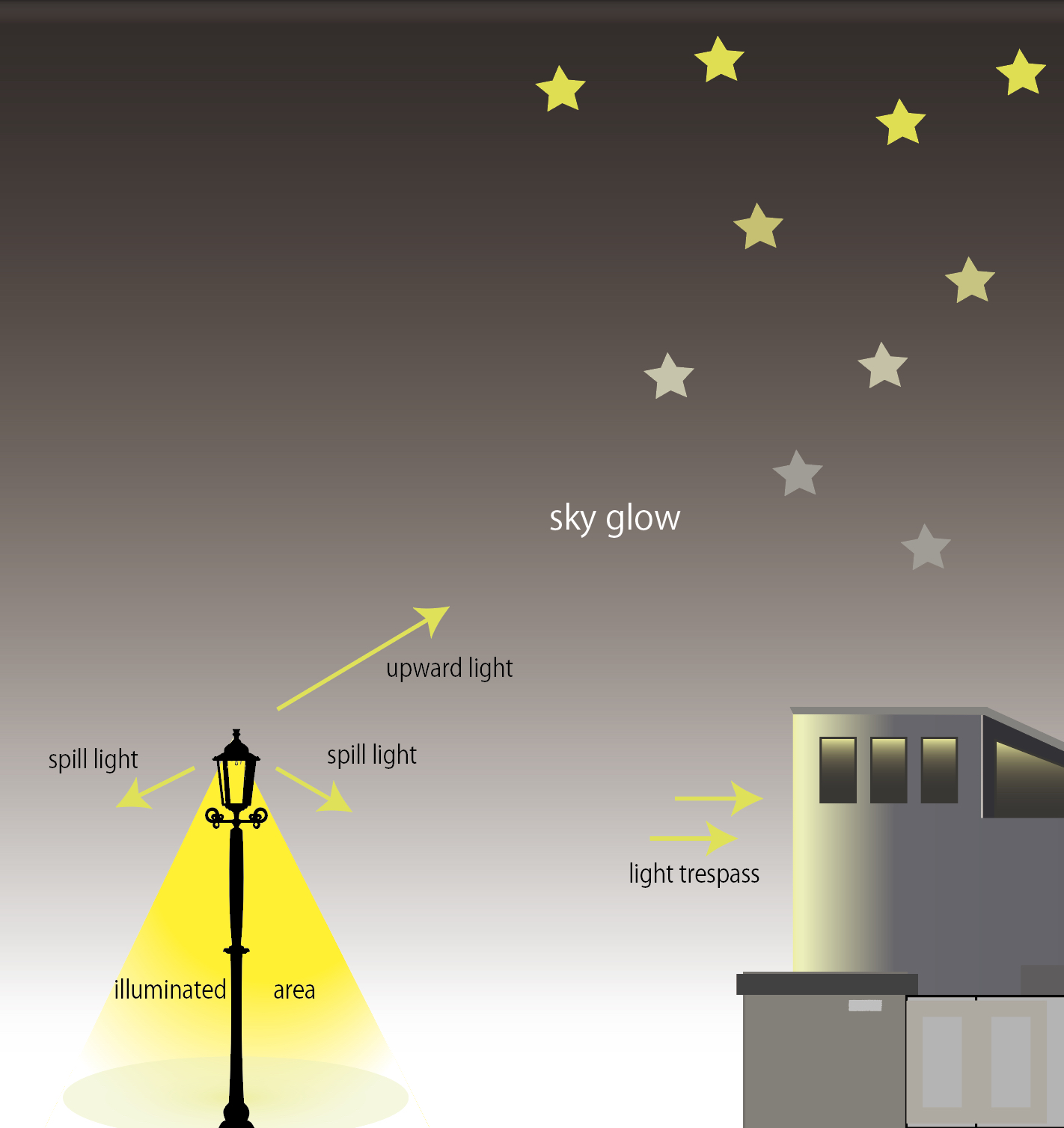
(Image for illustration purposes only.)
| Term | Definition |
| Night Sky Brightness | Night Sky Brightness refers to the brightness of the background between stars when observing the sky from the ground through the atmosphere. When observing stars, the lower the brightness of the background is, the better the observation conditions are. If the night sky brightness in a region is higher than it should be in natural lighting, it proves that light pollution exists in that region. |
| Stellar Magnitude | One of the units that indicate the brightness of stars is stellar magnitude represented in magnitude(mag). The smaller the number is, the brighter a star is. Celestial bodies brighter than 0 magnitude are represented by negative numbers. The apparently brightest star, Sirius in Canis Major, is -1.44 magnitude, and Vega in Lyra is 0.03 magnitude. In an ideal dark night sky, stars as dim as 6th magnitude can be seen with the naked eye. A difference of 5 magnitude is defined to correspond to a difference in brightness of exactly 100 times. It corresponds that a difference of 1 magnitude is equivalent to a change of about 2.5 times in brightness. |
| mag/arcsec2 (unit indicating the night sky brightness) |
The brightness of the background between stars near the zenith is shown in units of mag per square arcsecond (arcsec2).
The larger this value is, the darker the night sky appears and the easier it is to see the stars.
The ideal natural sky darkness is 21.6 mag / arcsec2, and the background brightness and visibility grades are as follows:
19 - 20 mag/arcsec2: Darkness in the countryside. The Milky Way is visible. 18 - 19 mag/arcsec2: Brightness in a residential area. The constellations can be easily seen. 17 - 18 mag/arcsec2: Brightness in a city. The constellations can be found with effort. less than 17 mag/arcsec2: Brightness in downtown areas. Almost no stars can be seen. |
| Bortle Scale | The Bortle scale is a nine-level brightness scale for assessing the night sky brightness, proposed by the astronomer John E. Bortle.
The brightness of the night sky is assigned a class from class 1, which is the darkest night sky, to class 9, which is the bright inner-city sky. Class 1 (Excellent dark-sky site) Class 2 (Typical truly dark site) Class 3 (Rural sky) Class 4 (Rural / suburban transition) Class 5 (Suburban sky) Class 6 (Bright suburban sky) Class 7 (Suburban / urban transition) Class 8 (City sky) Class 9 (Inner-city sky) |
| Light Pollution Map | A light pollution map is a map showing the brightness of the Earth at night, created based on images taken from artificial satellites. Click here for a map of light pollution around Tokyo. ▶Light pollution map |
| Color Temperature | Color temperature is a scale to describe the appearance of light. It is measured in Kelvin(K). When the color of light emitted by an object can be approximated by blackbody radiation, the light is assigned a color temperature based on the absolute temperature of a blackbody that would emit similarly colored light. The color temperature of sunlight is about 6000 K. More reddish light has a lower color temperature and more bluish light has a higher color temperature. Light with a high color temperature (bluish) is strongly scattered in the atmosphere, and light pollution is spread over a wide area. For this reason, lighting with a low color temperature is desirable to minimize light pollution. |
| Absolute Temperature (Kelvin) | Absolute temperature is measured in Kelvins(K).
The temperature at which the thermal motion of an atom or molecule becomes zero is defined as 0 K. Temperatures in Kelvins can be converted to Celsius using the following equation:
0 K = - 273.15 ℃ A one-degree increment in Kelvin is the same as that in Celsius. |
| Blackbody Radiation | A blackbody is defined as an ideal object that absorbs all incident light and does not reflect any light. Radiation from a blackbody is called blackbody radiation. As the temperature of a blackbody increases, it emits more electromagnetic waves with shorter wavelengths. |
| Low-Pressure Sodium (LPS) Lamp | A low-pressure sodium (LPS) lamp is a hot cathode discharge lamp that emits light with a wavelength of 589 nm produced by sodium atoms excited with an arc discharge. It has a low color temperature and its lighting color is orange. |
| Light Emitting Diode (LED) Lamp | A light emitting diode (LED) lamp has low power consumption and high luminous efficiency compared to incandescent light bulbs. The practical use of blue light emitting diodes has enabled LED lamps to emit white light, and now LED lamps are widely used for lighting. However, white LED lamps emit strong blue light with a high color temperature, and if the upward light flux is large, they may cause light pollution over a wide area. |
| LED security lights and LED streetlights for light pollution prevention | The International Dark-Sky Union has certified some lighting equipment as starry-sky-friendly lighting. They meet the standards of minimizing glare, requiring that there is no light leak to the upper luminous flux that makes it difficult to see the starry sky (upward light flux rate 0%), and the light bulb color has less blue light, being 3000 K(Kelvin) or less in color temperature. |
Other Terms Related to Light Pollution
| Term | Definition |
| Artificial Satellite | An artificial satellite is a manmade body in orbit around the Earth. There are various types of satellites including geostationary satellites at an altitude of 36,000 km above the equator and always at the same position as seen from the Earth, and low-earth orbit (LEO) satellites with orbits at an altitude of 2,000 km or less. In recent years, groups of satellites that form huge satellite networks called "Mega Constellations" have been launched. Artificial satellites reflect sunlight after sunset and before sunrise, and satellites at low orbits can be seen from the ground. Many companies have announced that they will launch mega constellations, and since the total number of satellites is planned to exceed tens of thousands, there are concerns about the impact on astronomy observations from sunlight reflected by the satellites. |




